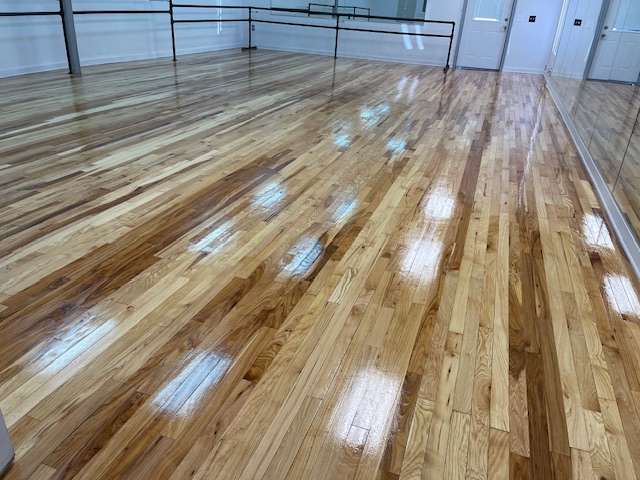DIY vs. Professional Hardwood Floor Refinishing

DIY vs. Professional Hardwood Floor Refinishing: Which is the Best Option for Your Floors?
By Choice Hardwoods
Hardwood floors are a beautiful and enduring feature in many homes. They add character, warmth, and elegance, often lasting for generations when properly cared for. However, over time, even the most durable hardwood floors will show signs of wear. Whether due to heavy foot traffic, pets, or spills, refinishing your floors can restore their original shine and beauty. This leaves many homeowners asking: Should I refinish my hardwood floors myself, or hire a professional?
At Choice Hardwoods, we understand that refinishing hardwood floors is an important investment, and that the decision to go DIY or professional is not one to be taken lightly. While refinishing can seem like a manageable project for the average homeowner, there are significant differences in quality, efficiency, and long-term results between DIY and professional refinishing.
In this article, we’ll explore the main differences between DIY and professional hardwood floor refinishing, including the pros and cons of each approach. We’ll also discuss common mistakes made by DIYers, the challenges of using inferior equipment, and why, in many cases, hiring a professional may be the best choice for achieving optimal results.
1. The Basics of Hardwood Floor Refinishing
Before we dive into the debate of DIY versus professional refinishing, it’s important to understand the refinishing process itself. At its core, refinishing hardwood floors involves sanding down the existing finish to reveal the fresh wood beneath, followed by the application of a new finish (typically polyurethane). The goal is to remove the old, worn-out finish, eliminate imperfections like scratches and dents, and restore the floor to its original beauty.
The process typically involves:
Sanding: This is the most labor-intensive and important part of the refinishing process. The sandpaper used in sanding machines removes the top layer of the floor’s finish and can also smooth out imperfections in the wood.
Staining (optional): After sanding, many homeowners choose to apply a stain to the wood to change its color or to accentuate its natural grain. Staining is optional and typically depends on personal taste.
Sealing and Finishing: Once the wood is prepped, a fresh protective layer of polyurethane or a similar finish is applied. This finish can be matte, satin, semi-gloss, or high-gloss, depending on the desired aesthetic. It’s essential for ensuring the floor is protected from future damage, including scratches, spills, and foot traffic.
Now that we understand the process, let’s look at the differences between tackling this project yourself versus hiring a professional.
2. Quality of Results: DIY vs. Professional
One of the most important factors to consider when deciding between DIY and professional refinishing is the quality of the finished product. A refinished hardwood floor should look smooth, even, and flawless, with no visible imperfections. Here’s how the two approaches compare:
DIY Refinishing:
When you take the DIY route, the quality of the result often depends on how much experience you have, the tools and materials you use, and the amount of time and effort you put into the job. Many DIYers are driven by the allure of saving money, and while this is certainly possible, the quality of the finish can be compromised for several reasons.
Inferior Equipment: Many DIYers rent equipment from local hardware stores or purchase tools online. Unfortunately, rental equipment is often outdated, poorly maintained, or not as powerful as professional-grade tools. Sanding machines are particularly important for achieving a smooth and consistent surface, and rented machines may leave behind unwanted sanding marks or fail to effectively remove the old finish. This can result in uneven surfaces, visible sanding marks, or an inconsistent final appearance.
Uneven Application of Finish: Applying the protective finish (polyurethane) requires precision to avoid streaks, bubbles, or uneven coverage. Many DIYers struggle to apply the finish evenly, which can result in a patchy appearance or a finish that doesn’t dry correctly.
Lack of Experience: Even if you rent high-quality equipment and follow the right steps, refinishing requires a skilled hand. Without experience, it’s easy to miss critical steps, apply too much or too little pressure when sanding, or over-apply the finish. These errors can lead to an unattractive final product that could have been avoided by professionals.
Professional Refinishing:
When you hire a professional refinishing company like Choice Hardwoods, you can expect a superior level of craftsmanship and a flawless final result. Professionals have years of experience and access to high-end equipmentthat is properly maintained to achieve a perfect finish.
High-Quality Equipment: Professional-grade equipment is typically more powerful, efficient, and precise than rental tools. High-quality sanding machines ensure that the floor is evenly sanded, while buffers are used to eliminate any imperfections that may have been left behind by the sanding process. This results in a smooth, uniform surface that is ready for staining or finishing.
Experience and Skill: A professional refinisher has the experience to handle the job efficiently. They know how to assess the wood’s condition, determine the right grit for the sandpaper, and apply finishes with the proper technique. As a result, the outcome will be far more precise, consistent, and durable.
Flawless Finish: With the expertise of professionals, you’re less likely to encounter issues such as streaks, bubbles, or uneven finishes. The final result will have a rich, even sheen that enhances the natural beauty of the wood.
3. Time and Labor: DIY vs. Professional
Refinishing hardwood floors can be a time-consuming and physically demanding process. How much time you spend on the project depends on the size of your floor, the condition of the wood, and your experience level. Here’s how the two approaches compare in terms of time and effort:
DIY Refinishing:
Longer Timeline: As a DIYer, you may find the process takes longer than you expect. If you’ve never refinished floors before, you’ll need to learn how to use the sanding equipment, apply the finish, and work around obstacles like furniture or baseboards. Even if you’ve done the job before, doing it yourself will still take longer than having professionals handle it.
Physical Labor: Refinishing floors requires a lot of physical effort, especially when it comes to sanding and applying the finish. The sanding process is particularly labor-intensive and can be quite tiring for those who aren’t used to manual work. It also creates a significant amount of dust that will need to be cleaned up afterward, adding even more time to the project.
Potential Delays: If you don’t have all the necessary equipment or encounter an issue (such as a rental machine malfunctioning), your project can be delayed. Additionally, the curing time for polyurethane can vary, which means your floor could be out of commission for days longer than expected.
Professional Refinishing:
Faster Timeline: Professionals are typically able to finish the job much more quickly than DIYers because they have the experience and the right equipment. A professional crew can often refinish a room in one or two days, while a DIY project may take much longer—especially if you’re working alone or without prior knowledge.
Efficient Workflow: Since refinishing is a core part of a professional’s business, they have systems in place that make the entire process more streamlined. Professionals can handle all the labor, from moving furniture to sanding, staining, and finishing, while you relax or focus on other things.
Minimal Disruption: While any refinishing project requires time for the finish to cure, professional companies like Choice Hardwoods are able to ensure that the process runs smoothly with minimal disruption to your daily routine. You’ll know the exact timeline upfront, and professionals will ensure your home is clean and tidy at the end of each workday.
4. Cost: DIY vs. Professional
Cost is a huge factor when deciding whether to go the DIY route or hire professionals. Here’s how the costs compare:
DIY Refinishing:
Material Costs: While you may save on labor costs by doing the work yourself, the materials can still add up. You’ll need to purchase (or rent) equipment like a drum sander, edger, and buffer, as well as sandpaper, polyurethane, stains (if desired), and other tools. Many DIYers underestimate the amount of material required for the project, which can result in hidden costs.
Rental Equipment Fees: Renting professional-grade equipment might seem like a cost-effective option, but rental fees can add up quickly. Additionally, many DIYers don’t know how to properly maintain rented equipment, which can lead to malfunctions and subpar results.
Hidden Costs of Mistakes: Many homeowners who attempt DIY refinishing end up needing to correct mistakes later on, such as fixing sanding marks or fixing issues with the finish. These mistakes can cost both time and money and may result in a poor final product that doesn’t live up to expectations.
Professional Refinishing:
Higher Initial Investment: Hiring a professional company may seem more expensive upfront, but the investment often pays off in the form of a higher-quality result, faster timeline, and fewer mistakes. With professionals handling the entire job, you’re paying for their expertise, high-quality equipment, and top-notch materials.
Long-Term Savings: While the upfront cost is higher, professional refinishing can save you money in the long run. A properly refinished floor will last longer, require less maintenance, and avoid the need for future repairs or refinishing. Additionally, professionals can help you select the best products for your floor type, maximizing the longevity of your investment.
5. Mistakes Made by DIYers
One of the main reasons why many DIY hardwood refinishing projects end in frustration is the errors that often occur due to inexperience. Here are some common mistakes made by DIYers that can lead to undesirable results:
Sanding Marks: Inadequate or improper sanding is one of the most common mistakes. Poorly maintained rental sanders or lack of experience can leave sanding marks that are difficult to fix without a full resanding.
Uneven Stain/Finish Application: Applying an even coat of finish is critical for a smooth, professional look. DIYers often struggle with this step, leading to blotchy or streaky floors.
Failure to Prep the Space: A professional refinisher will take care to properly prep the space, including moving furniture and protecting your walls. DIYers may overlook these steps, leading to unnecessary messes and potential damage to the floor or surrounding areas.
Conclusion
While refinishing hardwood floors may seem like an easy DIY project, the reality is that achieving a flawless finish requires significant expertise, high-quality equipment, and attention to detail. The differences in quality, time investment, cost, and results between DIY and professional refinishing are stark.
At Choice Hardwoods, we believe that hiring a professional is often the best option for homeowners who want the best possible results for their hardwood floors. With years of experience, high-end equipment, and a commitment to customer satisfaction, our team can help restore your floors to their former glory.
If you’re considering refinishing your hardwood floors, get in touch with us today. Let us help you make the right choice for your home and ensure your hardwood floors are as beautiful as they were when first installed.

